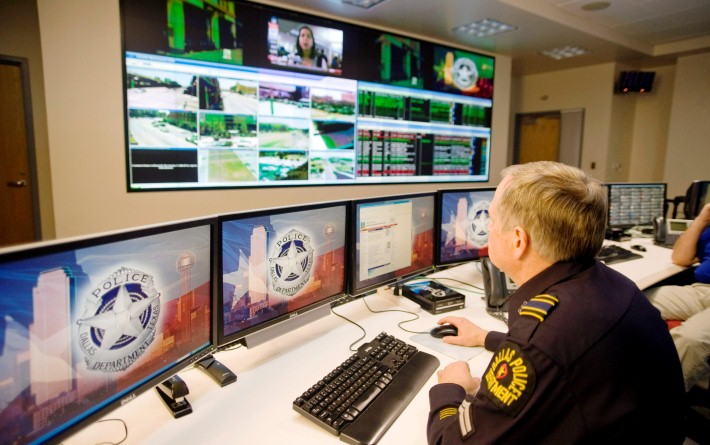
Online Exclusive: Collaborative Solutions for the Modern Control Room
With growing requirements for real-time video, graphics and data feeds visually assembled onto a large shared display system, the security control room enables staff to monitor multiple streams of information simultaneously and thus make faster and more accurate mission-critical decisions.
- By John Stark
- Mar 08, 2013

Security is one industry, among many, that relies heavily on an efficient control room to achieve its goals. Functioning as a centralized, designated space where staff monitors the security status of and access to critical assets, security control rooms provide users with a complete visual representation of the monitored environment. With growing requirements for real-time video, graphics and data feeds visually assembled onto a large shared display system, the security control room enables staff to monitor multiple streams of information simultaneously and thus make faster and more accurate mission-critical decisions.
Yet today’s control rooms go beyond the displaying and monitoring of information to achieve success. New and innovative visual display solutions and more collaborative infrastructures are removing boundaries and expanding the ability to share and react to information for many of the world’s most mission-critical operations. By integrating stunning zero-maintenance displays with the power of the network, they are completely redefining the control room space and setting the stage for an increasingly distributed control room environment. Across every sector in business, commerce and government, new technologies are raising the bar to meet today’s control room operational requirements.
The Center of Attention
Typical control room installations include an array of large format displays driven by a display wall processor that accepts inputs from a variety of sources, including desktop computers, broadcast and security videos. There are, however, faults with the traditional technologies and systems used; the biggest issue being that all of the information is displayed on only one place, which means that anyone not physically present in the control room can’t view the information and therefore act upon it. In other words, the very strength of the traditional control room can also be its weakness. The modern workforce has and continues to move toward a remote and decentralized structure where working from mobile devices and remote offices is the new normal. That means the same information assets must also be available to the workforce in the field, where they are sometimes in the better position to make life-critical decisions.
The Pro AV market has attempted to solve this problem by creating and implementing AV networks consisting of a central matrix switch capable of taking any input signal and replicating it to one or more outputs, with cabling connecting all the spaces and the display wall processors. But most existing AV systems cannot be easily modified by the end user, and thus, require money and time to make the necessary changes. A new, decentralized interface also requires training to operate and the networks are constructed with costly, space inefficient media with limited transmission distances, such as RGB or DVI cabling.
To achieve the ultimate goal of providing the same information, presented in the same format, at the same time, to all users regardless of their location, security organizations—and others that use control rooms—need an easily deployable, flexible, open platform that enables simultaneous and simple collaboration across a variety of environments—from the control room, to the meeting room, to the office, to the field environment.
“The solution to this gap between changing technologies and the evolving, mobile work force is the introduction of network distributed collaboration systems, with visual display technologies optimized for these systems,” noted John Stark, senior director of Collaborative Visual Solutions at Christie, one of the leading visual display companies providing products and technical support services for the control room environment.
In efforts to build such a collaboration system, Christie has created advanced video walls that more cost-effectively integrate with users’ existing hardware and software infrastructure, enabling them to capture and analyze real-time video from multiple inputs in multiple formats. They also recently introduced the Christie Phoenix open content management system, a new product that aims to eliminate the existing limitations on control rooms and redefines what collaboration should look like.
A network AV streaming appliance at its core, the Christie Phoenix node offers the ability to capture and encode content such as video or computer signals, control connected sources through soft-KVM, and decode display content onto one or more displays simultaneously. Multiple nodes, when attached to a users’ standard network, recognize each other automatically, recognize connected sources and displays and create a flexible mesh of AV streaming functionality. The Christie Phoenix can easily coexist within existing network deployments and is based on an encoding standard which most consumer devices already have the ability to decode, making it a cost-effective addition to any control room, with a minimal learning curve.
Beyond the Wall
Video walls have also been evolving to better integrate with faster, more efficient, more versatile technological infrastructures. Among the latest entries into the market is Christie MicroTiles, a modular video display system that is compact and shallow enough to fit into limited spaces and can be configured to create displays in various shapes and sizes. Last year, Christie MicroTiles were installed in the Dallas Police Department’s fusion center, where they are now able to handle signals from a wide range of sources.
“Our detectives monitor close to 100 cameras all around the city, including officer locations, calls and national live events, so the Dallas Police Department needed a reliable and versatile video wall that could help us maintain our 24-hour operation,” said Paul Schuster, senior corporal and special projects coordinator of the Dallas Police Department.
“A control room collaboration platform, from the display wall, to the video processor, to the entire AV infrastructure, must be designed around users sharing information freely and intuitively, wherever information is needed,” said John Stark. “They are the key to successful security operations. Whether it’s homeland security, airport security, computer security or retail loss prevention, all are important in our daily lives.”
With the increasing need for open, flexible and more multi-user focused solutions to control room challenges, the introduction of innovative technology has become vital to maximizing the success of the control rooms, and thereby the success of security organizations. A networked collaboration system can remove boundaries and enables expansive collaboration for many of the world’s most mission-critical operations.